Introduction
Currently working full-time in the central staff development team at UAL as a staff development consultant, I saw a valuable opportunity to focus my Inclusive Practices intervention on the recently launched learning staff development programme, Art of Management. This programme is dedicated to enhancing the development and experience of line managers across the university, ultimately aiming to improve the overall experience of all staff members and their teams.
As part of the Art of Management strategy, we are developing a line manager welcome event. This session is designed for both new managers joining UAL and newly appointed managers within the organisation. Its primary aim is to introduce what it means to be a line manager at UAL. Given the importance of this event in conveying key messages, I chose to use it as my intervention for the inclusive practices unit. My goal is to embed more substantial content on the applications of inclusive management, particularly in supporting staff members with disabilities and special adjustments. This will be achieved by highlighting relevant policies, trainings, and using examples for reflection.
By focusing on inclusivity, I believe we can not only significantly enhance the effectiveness of our management training but also stimulate the application of critical pedagogies in the development of UAL’s staff. According to Cowden and Singh (2013), critical pedagogy is vital because it is rooted in a humanistic view of human worth and value. To ensure that inclusivity is deeply integrated into UAL’s culture, we need to incorporate critical pedagogy into the way we design our knowledge exchange with not only students, but also staff members.
How does this fit with my positionality?
As the university emphasizes the importance of developing inclusive teaching to accommodate our diverse student cohorts, it is equally crucial to implement strategies that foster an inclusive environment and workspace also for all our staff members. Not to mention that, of course, the experience of our staff directly impacts the experience of our students across the university. Inclusivity for staff is essential in all instances and stages of their work experience, but for me particularly, in how they develop, learn, and feel motivated and supported.
Not being born and raised in the UK and coming from a country with numerous cultural differences, I am grateful to work in a team that not only values my unique experiences and background but also respects and accommodates the linguistic challenges I face sometimes. This makes it very important to me that all UAL employees feel similarly supported and encouraged to be themselves, so I strive to contribute to an inclusive staff development strategy where everyone can thrive and feel valued.
Additionally, considering Merriam’s et al. (2001 , p. 411, as cited in Bayeck 2022) interpretation that “positionality can shift depending on where the researcher stands at a specific moment, time, or space,” my recent promotion to a position where I will be line managing for the first time has made continuing to learn about inclusive practices even more significant. The role of line managers is crucial in supporting inclusive strategies within the organisation and this new responsibility is prompting me to reflect on what I need to ensure inclusivity not only in my own line management but also for all staff members across UAL.
Context- the pilot and what else moving forward
The line manager welcome event has been in development in collaboration with two colleagues that are staff development manager and organisational and staff development consultant. The first pilot was delivered last month and some important information on inclusive management was delivered to nine new line managers.
The event had a comprehensive agenda, beginning with an overview of UAL’s line management expectations. This was followed by presentations on key aspects of the university’s strategy, including social purpose, inclusivity, and well-being. Toward the end, our HR consultant team presented the five most important policies managers might use. These policies are crucial as they are closely tied to our inclusivity strategy.
Although inclusive management was not the primary focus of the workshop, it was a guiding principle throughout the planning process. I ensured that inclusivity was considered when designing the session and selecting the content. By incorporating these elements, we aimed to provide a holistic understanding of how inclusive practices can be seamlessly integrated into daily operations and overall strategy. This approach not only supports our commitment to diversity but also enhances the overall effectiveness and engagement of our management practices.
The slides dedicated to Inclusive Management highlighted UAL’s dedication to fostering an inclusive environment through a comprehensive EDI strategy, an antiracism action plan, and an access and participation plan for minority groups. Key several initiatives were presented including:
- The aim for 30% Black, Asian, and Minority Ethnic representation across all departments and uphold the Race Equality Charter;
- Disability Confidence Level 2 accreditation ensuring inclusivity for disabled and neurodiverse individuals;
- Mandatory EDI training, equality impact assessments, and support from champion forums and staff networks which further reinforce UAL’s commitment.
- The celebration of diversity by analysing staff survey results based on protected characteristics, and offering flexible working policies and additional training.
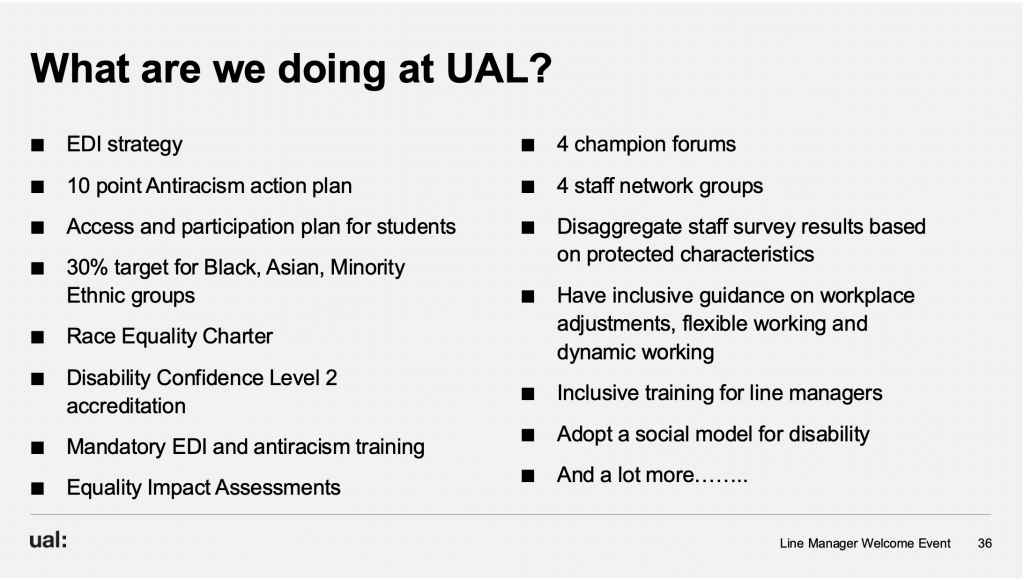
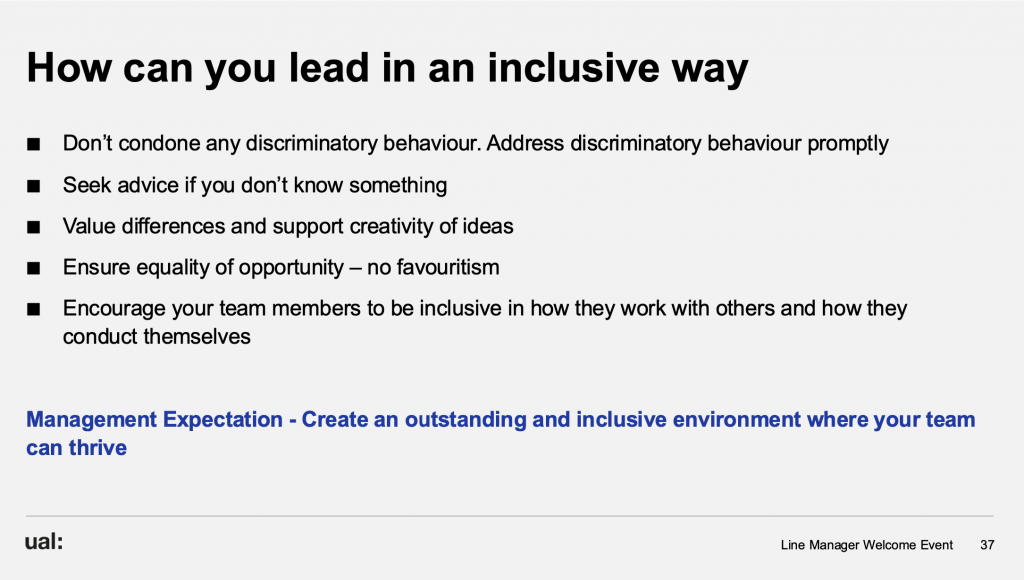
In addition to presenting inclusivity strategies and signposting information and resources, several event design strategies and activities were implemented to ensure an engaging and interactive session. These strategies were carefully considered to balance content-heavy segments with interactive elements, facilitating better engagement and interaction among the audience, and considering neuro-diverse perspectives.
The session began with introductions, followed by the first activity, which focused on identifying strengths and challenges in line management responsibilities. This activity encouraged participants to reflect on their roles and share their insights, which was successful in setting a supportive atmosphere in the room and making them interact with the room space by adding their post its to the flipchart.
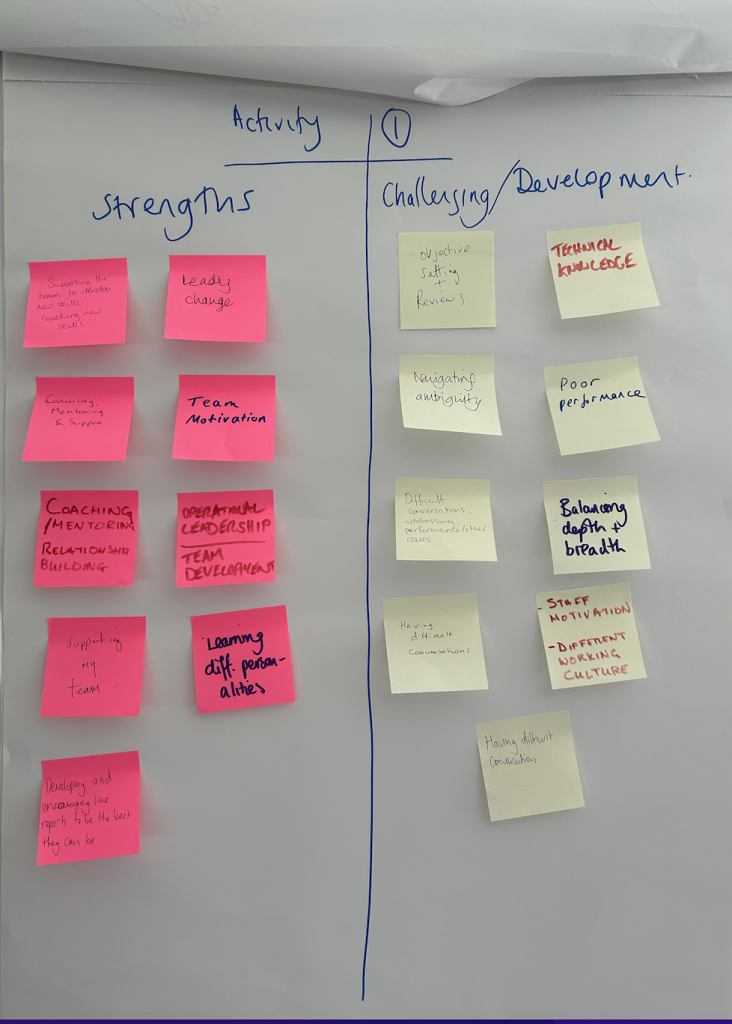
The second activity accompanied our presentation on UAL’s six Line Managers’ Expectations. After presenting each expectation, we asked delegates to indicate their confidence in achieving each one by marking dots on the circle (example below). Once all six expectations were presented, participants connected the dots and could visualise their strengths and development opportunities.
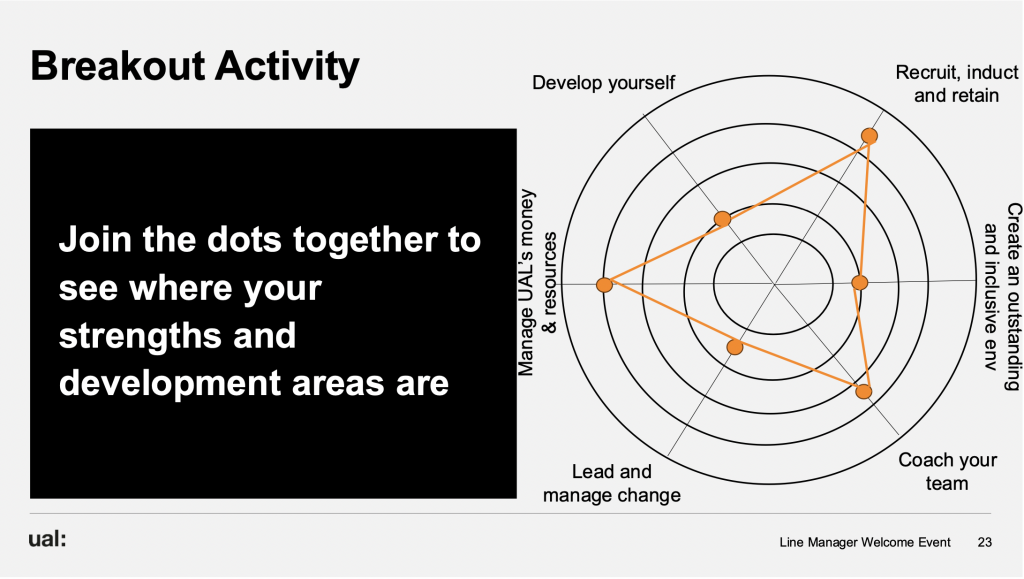
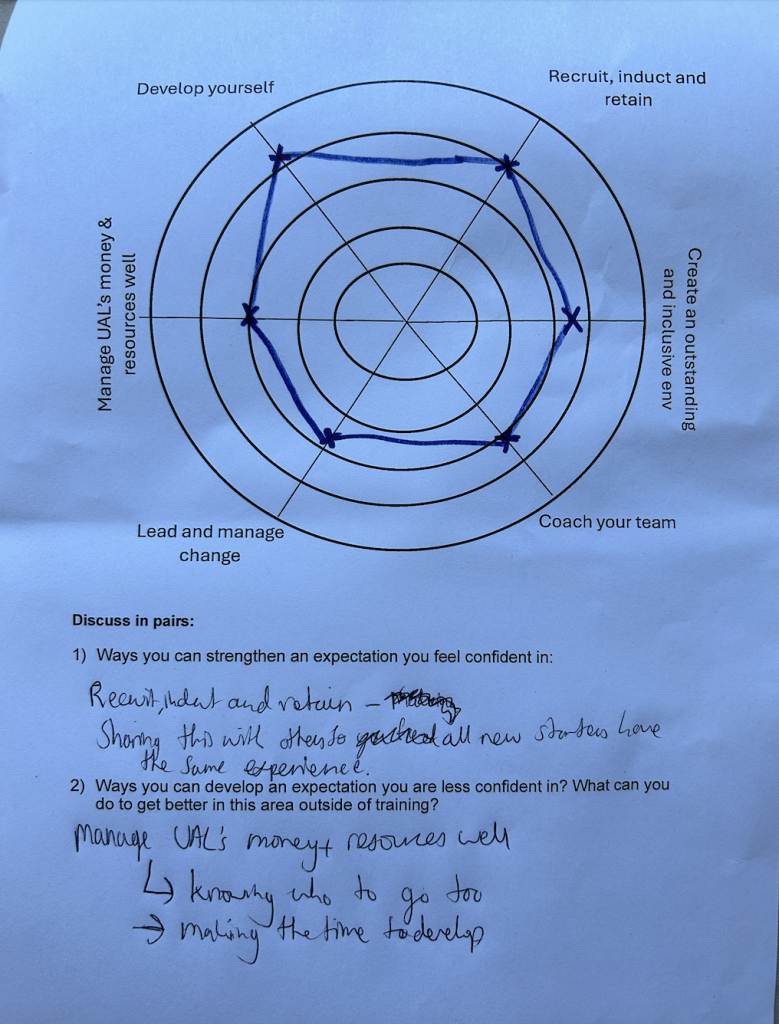
During the presentation, we discussed the resources and support UAL can provide. However, recognizing that some of the best learning comes from peer interactions and hands-on experience, we then asked delegates to work in pairs to look ar their circles and brainstorm ways to improve their confidence in meeting these expectations. The activity proved incredibly productive, sparking extensive discussion among the managers as they shared their experiences and insights.
Why it is important – UAL – Data
Part of the rationale for emphasizing inclusivity in the content selection and delivery strategy for the event stemmed from the 2023 UAL Staff Survey results. The survey revealed that respondents who declared a disability scored, on average, 11% lower than the university average across six themes: my role, enablement, management and leadership, working at UAL, diversity and inclusion, and engagement. Nearly 17% of survey respondents reported having a disability. Notably, those who identified as disabled scored 17 percentage points lower than non-disabled respondents on feeling they could be their true selves at work. This significant gap also appeared in responses to whether UAL values individuality, highlighting the need for focused efforts on inclusivity.
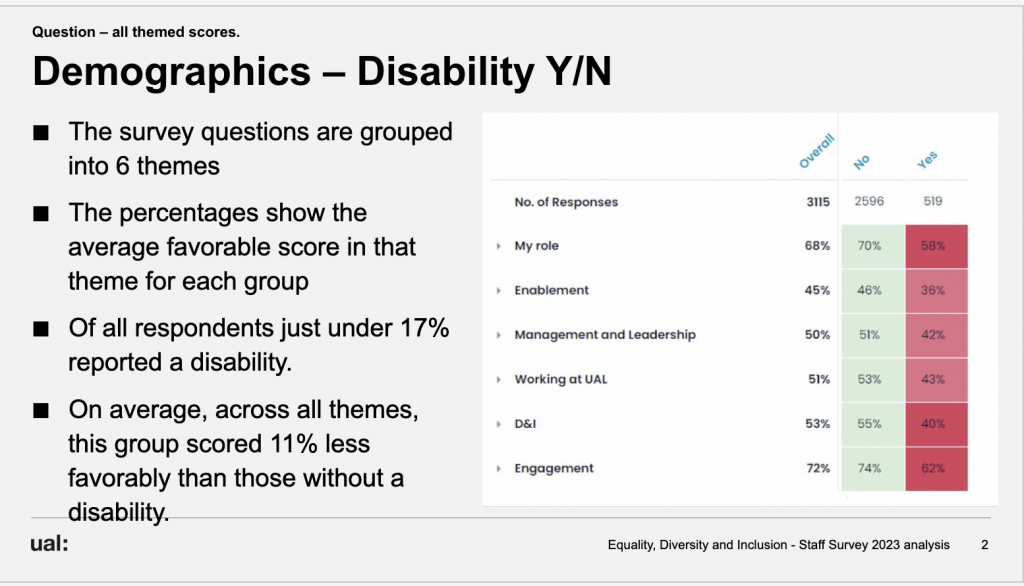
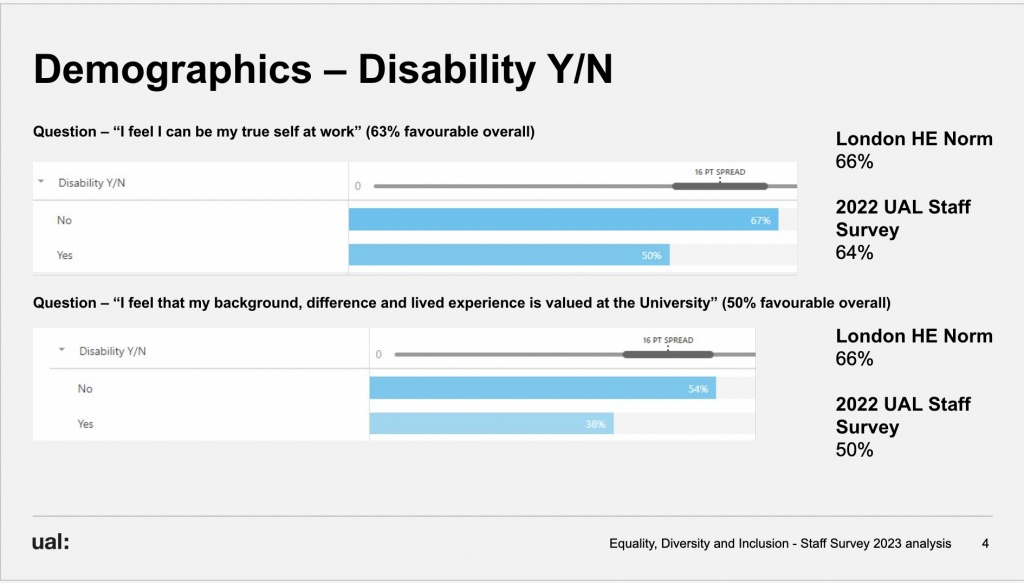
There is much to analyse in these results, especially when considering each type of disability. However, the key point I want to highlight is the urgent need for the entire organisation, particularly line managers, to focus on accommodating staff members with diverse needs. Line managers play a crucial role in implementing reasonable adjustments, ensuring that everyone feels included in the work environment and empowered to be their authentic selves.
Feedback
Feedback collection played a crucial role in developing the line manager welcome event and informed my decision to use it for my inclusive practices unit assignment. My colleagues and I received valuable feedback from our staff development, organisational development, and EDI teams regarding content and strategy. Additionally, we conducted an initial pilot session in April, gathering insightful feedback from the attendees. This feedback was instrumental in restructuring the session to make it more engaging and effective for the second pilot session. We have already received some really positive feedback for the second pilot, and also suggestions for improvements, which I am reviewing with a particular focus on inclusivity.
One clear takeaway from the last delivery, supported by feedback, was the session’s length in relation to the amount of content covered. Considering inclusivity, especially for neurodiverse staff, we need to extend the session to enhance accessibility, ensuring that all the information is not only delivered but also effectively absorbed by the attendees.
Lastly, as part of our internal feedback and reflection, we are scheduling a follow-up meeting with the group two months after the event to reconnect and foster a community of practice. A Teams channel is also being developed to support this effort.
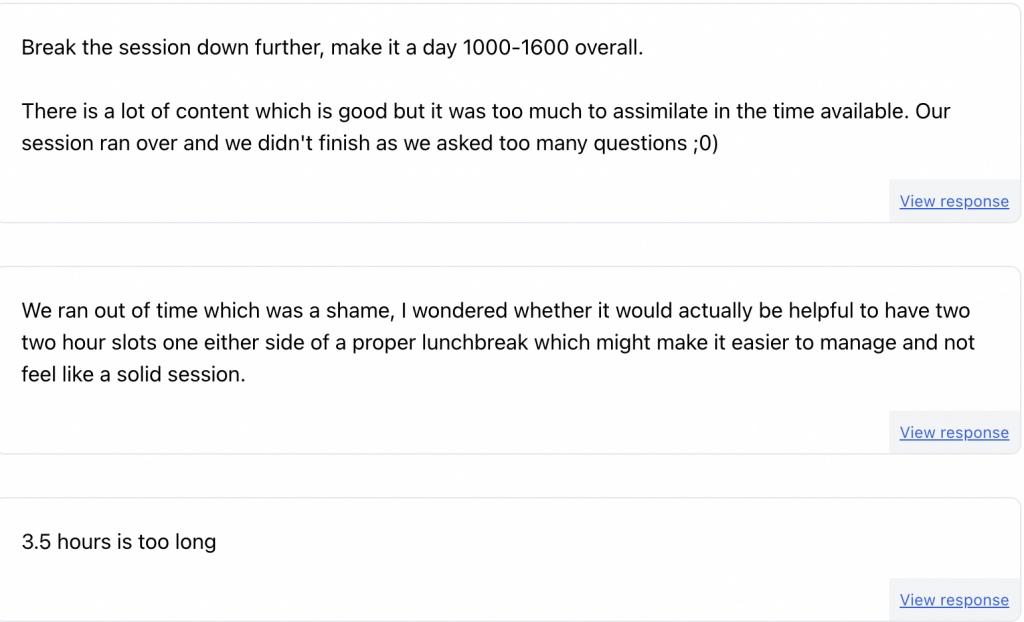
Further Reflections
Reflecting on my experience with this unit and the PGCert, I realize it has been an incredibly valuable opportunity to analyze how we deliver learning to staff at UAL. Coming from the academic side, where I have worked for the past three years, I see clearly how these two sides of UAL can learn a lot from each other. Communication and access to the right information is often a challenge within large organisations, and I could spend my entire reflection on how this interplay affects the experience of staff at UAL. However, the key point I want to highlight with my intervention is the crucial role of line managers in spreading best practices across UAL. While we already have excellent inclusive policies that support staff, there is a need for better understanding and application of these policies throughout university.
Regarding the development of the line manager welcome event, using it as my assignment for this unit has been a fantastic opportunity to reflect on inclusive practices and recognise that there is always more to learn and improve. While the event has been well-received, it has significant potential to foster even further dialogues on inclusivity, intersectionality, and the crucial role of adaptability in creating not only an inclusive organisation but also a productive and thriving one. By continuously refining the event approach and incorporating feedback, we want to ensure that our development programs will effectively support and empower all staff members.
References
Bayeck, R. Y. (2022). Positionality: The Interplay of Space, Context and Identity. International Journal of Qualitative Methods, 21. https://doi.org/10.1177/16094069221114745
Cowden, Stephen, and Gurnam Singh. Acts of Knowing : Critical Pedagogy in, Against and Beyond the University, Bloomsbury Academic & Professional, 2013. ProQuest Ebook Central, http://ebookcentral.proquest.com/lib/ual/detail.action?docID=1158309.
Bibliography
Brown, A. D. (2022) Identities in and around organizations: Towards an identity work perspective. Human Relations 75 (7), pp.1205-1237.
CIPD- Chartered Institute of Personnel and Development (2018). Neurodiversity at Work. Available at: https://www.cipd.org/globalassets/media/knowledge/knowledge-hub/guides/neurodiversity-at-work_2018_tcm18-37852.pdf#:~:text=URL%3A%20https%3A%2F%2Fwww.cipd.org%2Fglobalassets%2Fmedia%2Fknowledge%2Fknowledge. (Accessed: 27/05/2024).
Crenshaw, K. (1990) Mapping the margins: Intersectionality, identity politics, and violence against women of color. Stanford Law Review 43, p1241
Day-Duro, E., Brown, G. and Thompson, J. (2020). Thinking Differently: Neurodiversity in the Workplace. Available at: https://static1.squarespace.com/static/5a88ab00f43b552a84c3b7c9/t/5ef7af662801f1255ced9ee0/1593290657559/NeurodiversityWorkplace_REPORT.pdf. (Accessed: 27/05/2024).
Knowles, S. (2022) Building an inclusive workplace for neurodivergent employees. TLNT The Business of HR. Available at: https://www.tlnt.com/articles/building-an-inclusive-workplace-for-neurodivergent-employees. (Accessed: 27/05/2024)
Oliver, M. (1990) The Individual and Social Models of Disability. Paper presented at Joint Workshop of the Living Options Group and the Research Unit of the Royal College of Physicians, 23 July.